
Among the screenings at this weekend's San Francisco Iranian Film Festival is Six Centuries, Six Years, a fascinating documentary about the reconstruction and revival of the hitherto lost works of an icononic Persian-Turkish composer and musicologist.
The Shajarians, Iran's great father-and-son duo, are among the composers, musicians, and singers — men and women — who spent six years to recover the work of Abd al-Qadir Maraghi, who died in 1435.
Six centuries are just a short hop against the inheritance from the Sasanian Empire of 224-651 AD, but Maraghi's work had special importance in its influence on and variation from the more recent sources of both Iranian and Turkish classical music.
The documentary, directed by Mojtaba Mirtahmasb, deals with a complicated musical detective story, the mystery of Maraghi's work, which included the invention of a notation system and compositions most of which have been lost or hidden in Turkish museums.
(Mirtahmasb is best known for co-directing This Is Not a Film, a strange, bold venture responding to his jailing by the Tehran government and the prohibition against making films.)
A British Council essay explains the significance of Six Centuries, Six Years, which not only reconstructed the past and revived cultural pride but created new interest in Maraghi's almost lost-and-forgotten compositions:
If today's traditional music in Iran is under the heavy shadow of lyrics and poetry, this sixth-century-old music uses the singer's voice as a musical instrument. It breathtakingly repeats a word or breaks the word into high and low waves in a way that the poem is meaningless in its details and finds meaning only as a whole. This quality distinguishes Maraghi's music from any kind of Iranian traditional music today.
First presented by the Fajr Film Festival in Iran, Six Centuries, Six Years also resulted in an album of Maraghi's works. The documentary has a generous portion of rehearsal sessions, showing the musicians and singers working out interpretations of music for which no performance history exists.
Of special interest in the film is the active participation of women in the project against the still-existing prohibition of women performers in Iran. The Revolution of 1979 placed restrictions on all singing by women — conservative clerics said their voices "have the potential to trigger arousal" — but it has evolved into a specific ban on women singing solo in front of men who are unrelated to them. In the documentary, men and women work and perform together.
Unrelated to the film festival, but in the context of Iranian music, singer Sina Sarlak and the Nava Ensemble will give a concert Saturday at the de Young Museum, as part of the first NeekOn Festival. The Nava Ensemble was created by the late Tehran-born santur virtuoso Shahriar Saleh in 1995 for the preservation and performance of Persian classical music.

